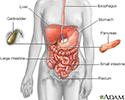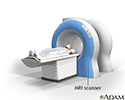Abdominal MRI scan
Nuclear magnetic resonance - abdomen; NMR - abdomen; Magnetic resonance imaging - abdomen; MRI of the abdomen; Liver MRI - abdomen; Pancreas MRI - abdomen; Kidney MRI - abdomenAn abdominal magnetic resonance imaging scan is an imaging test that uses powerful magnets and radio waves. The waves create pictures of the inside of the belly area. This test does not use radiation (x-rays).
Single magnetic resonance imaging (MRI) images are called slices. The images can be stored on a computer, viewed on a monitor, printed on film or scanned to a disk. One exam produces dozens or sometimes hundreds of images.
How the Test is Performed
You may be asked to wear a hospital gown or clothing without metal zippers or snaps (such as sweatpants and a t-shirt). Certain types of metal can cause blurry images.
You will lie on a narrow table. The table slides into a large tunnel-shaped scanner.
Some exams require a special dye (contrast). Most of the time, the dye is given during the test through a vein (IV) in your hand or forearm. The dye helps the radiologist see certain areas more clearly.
During the MRI, the person who operates the machine will watch you from another room. The test lasts about 30 to 60 minutes, but it may take longer.
How to Prepare for the Test
You may be asked not to eat or drink anything for 4 to 6 hours before the scan.
Tell your health care provider if you are afraid of close spaces (have claustrophobia). You may be given a medicine to help you feel sleepy and less anxious. Your provider may also suggest an open MRI, in which the machine is not as close to your body.
Before the test, tell your provider if you have:
- Artificial heart valves
- Brain aneurysm clips
- Heart defibrillator or pacemaker
- Inner ear (cochlear) implants
- Kidney disease or dialysis (you may not be able to receive contrast)
- Recently placed artificial joints
- Certain types of vascular stents
Stents
A stent is a tiny tube placed into a hollow structure in your body. This structure can be an artery, a vein, or another structure, such as the tube ...
 ImageRead Article Now Book Mark Article
ImageRead Article Now Book Mark Article - Worked with sheet metal in the past (you may need tests to check for metal pieces in your eyes)
Because the MRI contains strong magnets, metal objects are not allowed into the room with the MRI scanner. Avoid carrying items such as:
- Pocketknives, pens, and eyeglasses
- Watches, credit cards, jewelry, and hearing aids
- Hairpins, metal zippers, pins, and similar items
- Removable dental implants
How the Test will Feel
An MRI exam causes no pain. You may get medicine to relax you if you have a problem lying still or are very nervous. Moving too much can blur MRI images and cause errors.
The table may be hard or cold, but you can ask for a blanket or pillow. The machine makes loud thumping and humming noises when turned on. You can wear ear plugs to help reduce the noise.
An intercom in the room allows you to speak to someone at any time. Some MRI facilities have televisions and special headphones to help you pass time.
There is no recovery time, unless you were given a medicine to help you relax. After an MRI scan, you can go back to your normal diet, activity, and medicines.
Why the Test is Performed
An abdominal MRI provides detailed pictures of the belly area from many views. It is often used to clarify findings from earlier ultrasound or CT scan exams.
CT
A computed tomography (CT) scan is an imaging method that uses x-rays to create pictures of cross-sections of the body. Related tests include:Abdomin...

This test may be used to look at:
- Blood flow in the abdomen
- Blood vessels in the abdomen
- The cause of abdominal pain or swelling
- The cause of abnormal blood test results, such as liver or kidney problems
- Lymph nodes in the abdomen
- Masses in the liver, kidneys, adrenals, pancreas, or spleen
MRI can distinguish tumors from normal tissues. This can help your provider know more about the tumor such as size, severity, and spread. This is called staging.
In some cases it can give better information about masses in the abdomen than CT.
What Abnormal Results Mean
An abnormal result may be due to:
- Abdominal aortic aneurysm
- Abscess
Abscess
An abscess is a collection of pus in any part of the body. In most cases, the area around an abscess is swollen and inflamed.
 ImageRead Article Now Book Mark Article
ImageRead Article Now Book Mark Article - Cancer or tumors that involves the adrenal glands, liver, gallbladder, pancreas, kidneys, ureters, intestines or bladder
Cancer
Cancer is the uncontrolled growth of abnormal cells in the body. Cancerous cells are also called malignant cells.
Read Article Now Book Mark ArticlePancreas
Pancreatic cancer is cancer that starts in the pancreas.
 ImageRead Article Now Book Mark Article
ImageRead Article Now Book Mark Article - Enlarged spleen or liver
Enlarged spleen
Splenomegaly is a larger-than-normal spleen. The spleen is an organ in the upper left part of the belly.
 ImageRead Article Now Book Mark Article
ImageRead Article Now Book Mark Article - Gallbladder or bile duct problems
Bile
Bile is a fluid that is made and released by the liver and stored in the gallbladder. Bile helps with digestion. It breaks down fats into fatty acid...
 ImageRead Article Now Book Mark Article
ImageRead Article Now Book Mark Article - Hemangiomas
Hemangiomas
Red birthmarks are skin markings created by blood vessels close to the skin surface. They develop before or shortly after birth.
 ImageRead Article Now Book Mark Article
ImageRead Article Now Book Mark Article - Hydronephrosis (kidney swelling from the backflow of urine)
Hydronephrosis
Hydronephrosis is swelling of one kidney due to a backup of urine. This problem may occur in one kidney.
 ImageRead Article Now Book Mark Article
ImageRead Article Now Book Mark Article - Kidney infection
- Kidney damage or diseases
- Kidney stones
- Enlarged lymph nodes
- Obstructed inferior vena cava
Obstructed inferior vena cava
SVC obstruction is a narrowing or blockage of the superior vena cava (SVC), which is the second largest vein in the human body. The superior vena ca...
 ImageRead Article Now Book Mark Article
ImageRead Article Now Book Mark Article - Portal vein obstruction (liver)
- Blockage or narrowing of the arteries that supply the kidneys
- Renal vein thrombosis
Renal vein thrombosis
Renal vein thrombosis is a blood clot that develops in the vein that drains blood from the kidney.
 ImageRead Article Now Book Mark Article
ImageRead Article Now Book Mark Article - Kidney or liver transplant rejection
Transplant rejection
Transplant rejection is a process in which a transplant recipient's immune system attacks the transplanted organ or tissue.
 ImageRead Article Now Book Mark Article
ImageRead Article Now Book Mark Article - Cirrhosis of the liver
Cirrhosis of the liver
Cirrhosis is scarring of the liver and poor liver function. It is the last stage of chronic liver disease.
 ImageRead Article Now Book Mark Article
ImageRead Article Now Book Mark Article - Spread of cancers that began outside the belly
Risks
MRI does not use ionizing radiation. No side effects from the magnetic fields and radio waves have been reported.
The most common type of contrast (dye) used is gadolinium. It is very safe. Allergic reactions are rare but can occur. If you have a history of severe allergic reactions to other medicines you should notify your doctor. In addition, gadolinium can be harmful to people with kidney problems who need dialysis. Tell your provider before the test if you have kidney problems.
The strong magnetic fields created during an MRI can cause heart pacemakers and other implants not to work as well. The magnets can also cause a piece of metal inside your body to move or shift.
References
Al Sarraf AA, McLaughlin PD, Maher MM. Current status of imaging of the gastrointestinal tract. In: Adam A, Dixon AK, Gillard JH, Schaefer-Prokop CM, eds. Grainger & Allison's Diagnostic Radiology: A Textbook of Medical Imaging. 7th ed. Philadelphia, PA: Elsevier; 2021:chap 18.
Carucci LR. Diagnostic imaging procedures in gastroenterology. In: Goldman L, Cooney KA, eds. Goldman-Cecil Medicine. 27th ed. Philadelphia, PA: Elsevier; 2024:chap 119.
Mileto A, Boll DT. Liver: normal anatomy, imaging techniques, and diffuse diseases. In: Haaga JR, Boll DT, eds. CT and MRI of the Whole Body. 6th ed. Philadelphia, PA: Elsevier; 2017:chap 43.
Digestive system - illustration
The esophagus, stomach, large and small intestine, aided by the liver, gallbladder and pancreas convert the nutritive components of food into energy and break down the non-nutritive components into waste to be excreted.
Digestive system
illustration
MRI scans - illustration
MRI stands for magnetic resonance imaging. It allows imaging of the interior of the body without using x-rays or other types of ionizing radiation. An MRI scan is capable of showing fine detail of different tissues.
MRI scans
illustration
Digestive system - illustration
The esophagus, stomach, large and small intestine, aided by the liver, gallbladder and pancreas convert the nutritive components of food into energy and break down the non-nutritive components into waste to be excreted.
Digestive system
illustration
MRI scans - illustration
MRI stands for magnetic resonance imaging. It allows imaging of the interior of the body without using x-rays or other types of ionizing radiation. An MRI scan is capable of showing fine detail of different tissues.
MRI scans
illustration
Review Date: 7/15/2024
Reviewed By: Jason Levy, MD, FSIR, Northside Radiology Associates, Atlanta, GA. Also reviewed by David C. Dugdale, MD, Medical Director, Brenda Conaway, Editorial Director, and the A.D.A.M. Editorial team.



